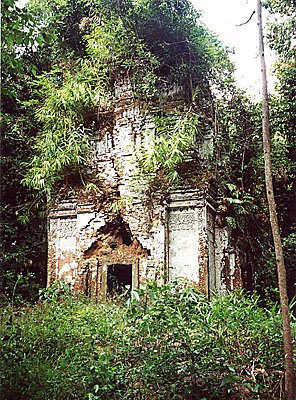Excavation on Kulen
The Phnom Kulen Archaeological Project
Lying 30 km outside of Angkor Archaeological Park is the cool, leafy retreat of Phnom Kulen. Best known as a popular picnic spot and location of the exquisite riverbed carvings known as the River of 1000 Lingas, archaeology buffs might also be familiar with the mountain as the location of the Angkorian period Kulen ware pottery kilns. But farther up the mountain and deeper into the misty jungle lay dozens of archaeological sites ranging from towering brick prasats, to cave sites, to water features. Until recently there had been little research done on these sites, but the Phnom Kulen Archaeological Program, in collaboration with the Apsara National Authority and funded by the Archaeology & Development Foundation, has begun a three-year project aimed at excavating, mapping, conserving and maintaining these sites.
Project Director Jean-Baptiste Chevance first visited the sites on Phnom Kulen Mountain in 2000 but did not have the funding to being research until January 2008. In its first field season the project has focused on conservation and excavation around three brick temple sites: Prasat Thma Dap, Prasat Neak Ta and Prasat, Anlong Thom. “Excavation is one part of the conservation process. It allow us to know the nature of foundations, the exact size of each site and to propose a perimeter for protection,” says Chevance. “Excavating Neak Ta and specially Thma Dap gave [us] a lot of information about peripheral structures.” Prasat Thma Dap had been previously excavated in the early 20th century by French archaeologists, however Chevance wanted to revisit and expand the initial test pits. Appearing as a lone brick temple nestled in the thick jungle the recent excavation has revealed a large area of occupation immediately around the temple. There is a second laterite tower, a surrounding wall, a causeway going to the East, a gopura, and evidence for wooden architecture. There is also the impressive brick and stuccowork on the temple itself.
In addition to excavation at these sites the team is also working on creating a more detailed map of all archaeological sites on the mountain in order to identify other sites in more urgent need of conservation. Sites slated for research in upcoming field seasons such as Rong Chen pyramid and Poeng Tbal cave, have also been mapped in detail. Chevance explains that this comprehensive research is necessary “in order to have a better vision on the occupation of the mountain.” The mountain is believed to have been inhabited from the 8th century AD to the end of the Angkorian period. It was initially rumored to have been a capital during the Jayavarman II period and later became a popular location for hermits from the 11th to 13th centuries. Archaeological research will help clarify how the Angkorian people used the mountain.
Despite the close proximity to Angkor there are no immediate plans for tourism. The sites are difficult to access, requiring a bumpy ride through narrow muddy paths. Additionally there is omnipresent danger of landmines and UXOs. Chevance notes that at the 5 sites that were de-mined prior to fieldwork 4 had unexploded UXOs. Even with the danger and difficulty of doing archaeological research on Phnom Kulen, PKAP team is looking forward to continuing field seasons. The project’s work in mapping, excavating, and conserving the sites on Phnom Kulen promises to provide useful data for expanding the archaeological record of this period, as well as helping villagers and preserving a unique part of Cambodian history. Article posted courtesy of Alison In Cambodia.



5 Comments:
Hi Andy- I should correct you that this article is not yet in the latest edition of TouchStone but will appear in an upcoming issue. Thanks for the link!
there are things I can't understand in this "blog eats blog" (brouwer dixit) world...
after shamelessly stealing from alison, why don't you link your blog to hers like she did with yours??? - horace blakey
horace,
its a good point and I had planned to do it yesterday, but my memory failed me and it didn't happen. it will happen...and I'm sure Alison will be pleased you are looking after her interests.
i appreciated yr answer, though i'm not exactly looking after her interests, but only opposing a certain mentality. no blog is an island.
thanks. - horace blakey
I agree with your friend: beeing responsable on this project, i would have appriciate to be informed of its publication on the net before its publication in Touchstone....
Post a Comment
<< Home